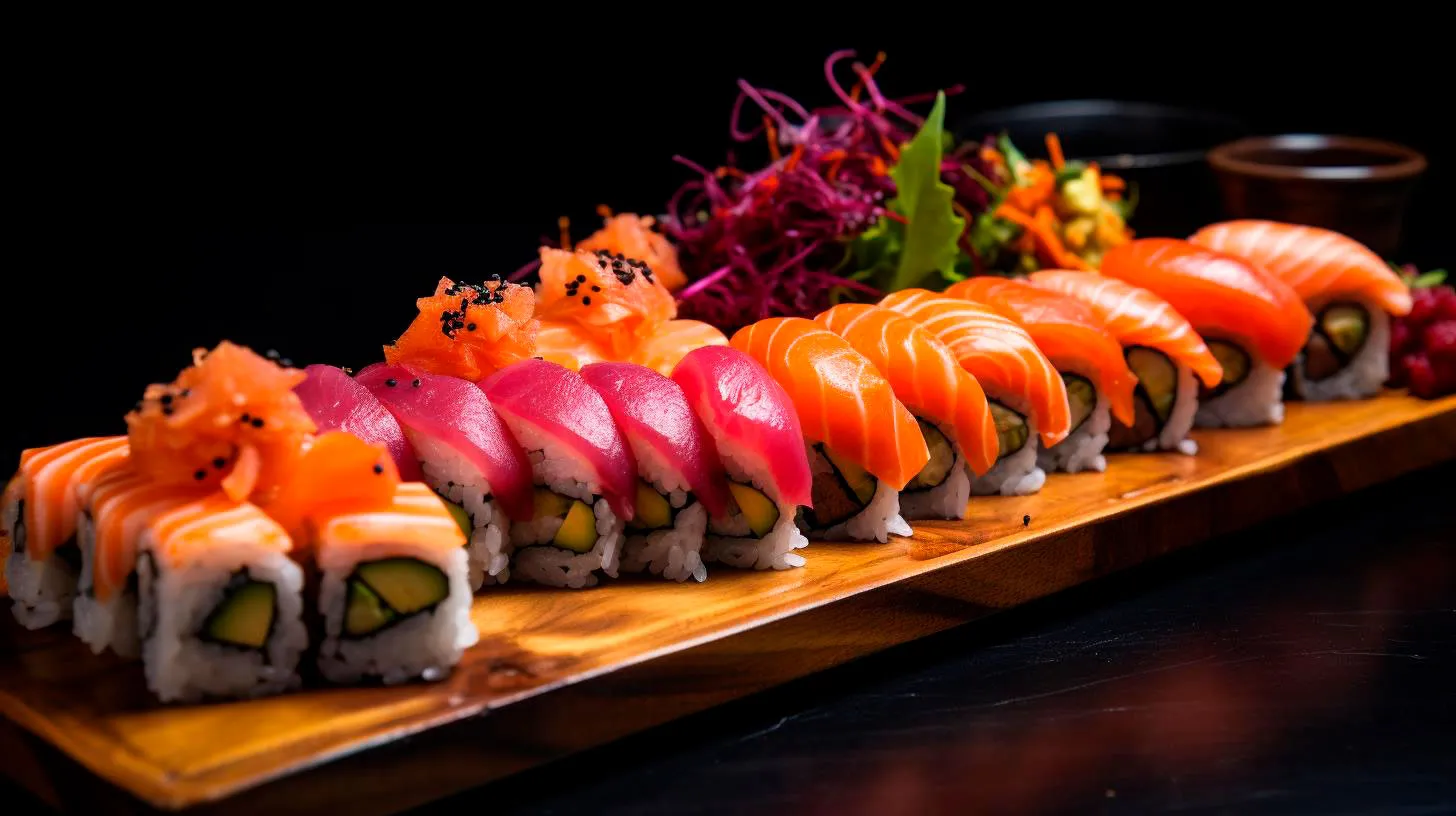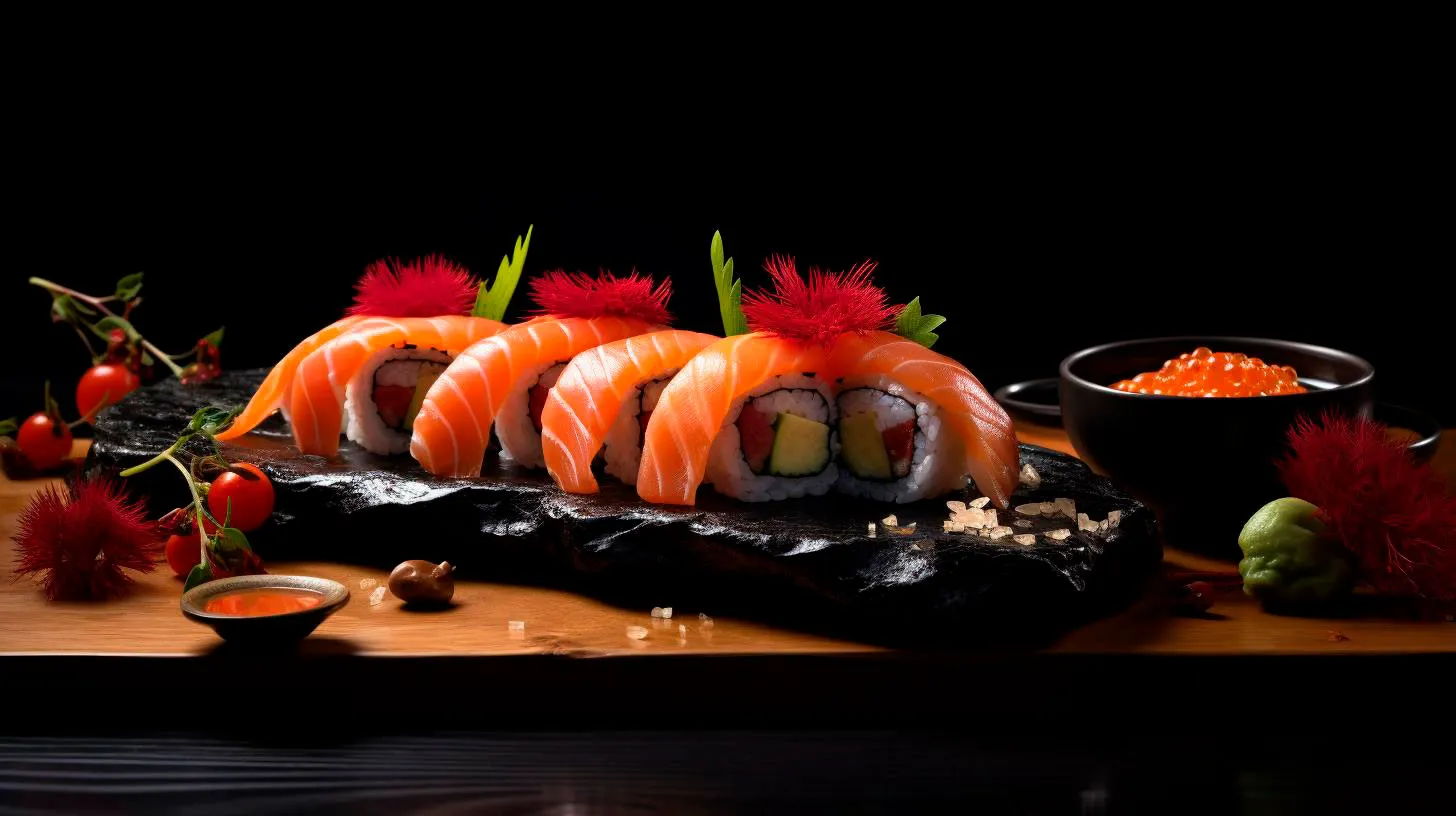Exploring International Influences in Sushi: Unlocking Innovative Flavor Combinations
In this article, we will uncover the fascinating journey of sushi, its international adaptations, and the unique taste experiences it offers.
The Evolution of Sushi
Sushi has a rich history dating back over a thousand years. Traditional Japanese sushi primarily consisted of rice mixed with vinegar, combined with fish or seafood. This simplistic yet flavorful combination quickly gained popularity within Japan.
However, as sushi spread to different parts of the world, it underwent an evolution to suit local tastes and preferences. This led to the emergence of various regional sushi styles, each incorporating unique ingredients and preparation methods.
International Influences Shaping Sushi
Sushi’s journey from Japan to other countries has brought forth diverse culinary influences, resulting in the creation of exciting flavor combinations. Let’s explore some of the key international influences and their contributions to sushi’s evolution:
- American Influence: In the United States, the introduction of the California Roll revolutionized sushi by incorporating avocado, cucumber, and crab meat. This innovation made sushi more accessible to those who were hesitant to try raw fish, paving the way for sushi’s global popularity.
- Brazilian Influence: Brazil’s sushi culture blends traditional Japanese techniques with local ingredients such as cream cheese and mango. This fusion creates a unique flavor profile that perfectly represents the diverse culinary landscape of Brazil.
- Hawaiian Influence: The famous Hawaiian dish, poke, has influenced sushi by introducing marinated raw fish alongside traditional sushi ingredients. This addition brings a burst of tangy and bold flavors to each roll.
- Peruvian Influence: Peru’s Nikkei cuisine incorporates Peruvian flavors and ingredients into traditional Japanese dishes, including sushi. The inclusion of jalapeño, cilantro, and spicy Peruvian sauces adds a delightful kick to the already delicious sushi rolls.
These international influences have significantly expanded the range of sushi flavors and elevated it into a truly global culinary delight.
Advantages of International Influences in Sushi
The incorporation of international influences in sushi offers several advantages, resulting in an exceptional dining experience. Let’s delve into the key benefits:
- Enhanced Flavor Profiles: The combination of international ingredients and techniques introduces new flavor dimensions to sushi, tantalizing taste buds like never before. The fusion of different cuisines creates a symphony of flavors, making every bite a delicious adventure.
- Cultural Exchange: International influences in sushi foster cultural exchange as culinary traditions from different countries blend together. It promotes understanding, appreciation, and celebration of diverse cultures around the world, making sushi more than just a meal but a cultural bridge between nations.
- Expanded Choices: The influx of international influences in sushi provides an extensive range of options for sushi lovers. From traditional Japanese rolls to innovative fusion creations, there is something to suit every palate and dietary preference.
- Creative Innovation: International influences inspire chefs to push the boundaries of creativity, resulting in innovative sushi combinations that surprise and delight diners. This constant evolution ensures that sushi remains fresh and exciting, continuing to captivate food enthusiasts.
Key Takeaways
Sushi’s journey from its traditional Japanese roots to the global culinary stage is a testament to its adaptability and universal appeal. The incorporation of international influences in sushi has unlocked innovative flavor combinations that intrigue and satisfy food lovers worldwide.
As we continue to explore the diverse culinary treasures around the world, sushi serves as a shining example of how cultural exchange and innovative thinking can create culinary masterpieces. So, embrace the fusion of flavors, indulge in international influences, and let your taste buds embark on an unforgettable sushi adventure!
The Rise of Sushi Fusion: A Creative Blend of Japanese and Global Flavors
However, a new trend is emerging in the world of sushi – fusion. Sushi fusion combines traditional Japanese techniques and flavors with influences from other cuisines, resulting in a creative blend of tastes and textures that is both innovative and delicious.
Although sushi has a long history in Japan, it wasn’t until the 1960s that it gained international recognition. Since then, sushi has evolved and adapted to suit different palates and cultures. Sushi fusion takes this adaptation to another level by incorporating ingredients and techniques from various cuisines, resulting in unique and exciting flavor combinations.
What Makes Sushi Fusion Special?
1. Creative Flavor Combinations: Sushi fusion allows chefs to experiment with different ingredients and flavors. Traditional sushi often features seafood, but fusion sushi expands the options to include ingredients like avocado, mango, or even foie gras. These unexpected combinations create a whole new dining experience, enticing both sushi enthusiasts and those new to the cuisine to explore and try something different.
2. Global Influence: Sushi fusion embraces global flavors, incorporating influences from cuisines as diverse as Thai, Mexican, and French. It takes the best elements of these cuisines and combines them with traditional Japanese techniques, resulting in an explosion of taste and texture. For example, a sushi roll might combine fresh tuna with spicy sriracha sauce, cilantro, and lime, creating a mouthwatering blend of flavors inspired by both Japanese and Mexican cuisines.
3. Innovative Presentations: In addition to experimenting with flavors, sushi fusion chefs also take creative liberties with the presentation. Traditional sushi is often simple and understated, focusing on highlighting the natural beauty and freshness of the ingredients. However, fusion sushi takes a more artistic approach, using colorful sauces, edible flowers, and intricate garnishes to create stunning visual displays. The presentation itself becomes part of the dining experience, adding an extra element of excitement and anticipation.
The Growing Popularity of Sushi Fusion
The rise of sushi fusion can be attributed to several factors, including the increasing openness of diners to try new flavors and the globalization of the culinary world. Fusion cuisine, in general, has gained popularity over the years as chefs experiment with different ingredients and techniques from around the world.
According to recent statistics:
- Global sushi market revenue is projected to reach $26.4 billion by 2022, with an annual growth rate of 4.1%.
- In the United States, the market size for fusion sushi has grown by 14.6% in the past five years.
- 75% of Americans have either tried sushi or are willing to try it, indicating a growing interest in this cuisine.
The increasing popularity of sushi fusion can also be attributed to its appeal to a wider audience. By incorporating flavors from different cuisines, sushi fusion appeals to those who may find traditional sushi too unfamiliar or intimidating. This opens up new possibilities for sushi restaurants to attract a diverse range of customers and expand their offerings.
Key Takeaways
- Sushi fusion combines traditional Japanese techniques with global flavors, resulting in innovative flavor combinations and unique dining experiences.
- It appeals to a wider audience by incorporating ingredients and flavors from different cuisines.
- Sushi fusion allows chefs to experiment not only with flavors but also with creative presentations, making it an exciting and visually stunning dining experience.
- The popularity of sushi fusion is growing worldwide, with an increasing number of people willing to try this creative blend of Japanese and global flavors.
As the culinary world continues to evolve, sushi fusion represents an exciting and delicious blend of traditional and modern tastes. Whether you’re a sushi enthusiast or someone looking to try something new, exploring the world of sushi fusion is an adventure worth embarking on.
Sushi Fusion Incorporating International Techniques for a Modern Twist on Tradition
From fusion flavors to innovative sushi-making methods, the sushi scene is evolving, offering an exciting and unique dining experience for sushi lovers.
1. Fusion Flavors: A Culinary Adventure
With sushi fusion, the boundaries of traditional flavors are pushed, resulting in a tantalizing taste experience. By blending ingredients and techniques from different cuisines, sushi chefs create unexpected combinations that surprise and delight. Some popular fusion sushi flavors include:
- Spicy Tuna Roll with Latin American influences, combining the heat of jalapenos with the freshness of avocado
- Crunchy Tempura Roll inspired by Japanese-American cuisine, featuring deep-fried shrimp or vegetables for a satisfying crunch
- Mango Salmon Roll with a touch of tropical sweetness, adding a refreshing twist to the traditional salmon roll
These fusion flavors not only add excitement to traditional sushi but also provide an opportunity to explore new and unique taste sensations.
2. Innovative Sushi-Making Techniques
Alongside fusion flavors, sushi chefs are also incorporating innovative techniques to enhance the visual appeal and texture of their creations. These techniques push the boundaries of traditional sushi-making while maintaining the essence of the dish. Some notable techniques include:
- Nigiri Pizzas: A playful twist on the classic Italian dish, topping bite-sized sushi rice with various ingredients such as sashimi, seaweed, and soy sauce to create a mini sushi pizza
- Sushi Burritos: A fusion of sushi and Mexican cuisine, these oversized sushi rolls wrap a combination of ingredients in a seaweed wrap, creating a satisfying handheld meal
- Roll-less Sushi: Breaking free from the usual sushi roll format, this technique presents the ingredients and fillings in a layered manner, showcasing each component beautifully
These innovative techniques not only add novelty to sushi but also showcase the creativity and skill of sushi chefs, resulting in a visual feast for the eyes.
3. Key Takeaways from Sushi Fusion
Sushi fusion brings a fresh perspective to the culinary world, breathing new life into a traditional dish while respecting its roots. Here are some key takeaways from this modern twist on sushi:
- Unforgettable flavors: Fusion sushi introduces unexpected flavors that tantalize the taste buds, creating a memorable dining experience.
- Creative presentation: Innovative techniques result in visually stunning sushi creations that are a feast for the eyes.
- Exploration of new tastes: Sushi fusion encourages diners to step out of their comfort zone and explore unique combinations and flavors.
- Embracing culinary diversity: Incorporating international techniques celebrates the richness of global cuisines and promotes cultural fusion.
Sushi fusion has gained significant popularity in recent years, with a growing number of sushi restaurants embracing these modern techniques and flavors. As diners become more adventurous and open to culinary experimentation, sushi fusion offers a refreshing and exciting alternative to traditional sushi.
Conclusion
Sushi fusion presents a thrilling evolution of the traditional Japanese dish, incorporating international techniques and flavors to create a modern twist on tradition. With fusion flavors and innovative sushi-making techniques, sushi fusion invites diners on a culinary adventure, exploring new tastes and textures. This trend celebrates the creativity and skill of sushi chefs while offering a memorable dining experience for food enthusiasts around the globe. So, the next time you crave sushi, why not embark on a journey of flavors with sushi fusion? You’ll be in for a delicious and unforgettable treat!
From Tokyo to the World: Embracing Global Ingredients in Sushi Fusion Cuisine
In this article, we will explore how sushi fusion cuisine has embraced global ingredients and revolutionized the way we enjoy this traditional delicacy.
The Evolution of Sushi Fusion Cuisine
While traditional sushi features fresh fish and seafood, the fusion of different culinary cultures has led to the incorporation of diverse ingredients from around the world. Chefs are now combining traditional Japanese flavors with ingredients like avocado, mango, truffle oil, and even foie gras, to create mouthwatering sushi rolls with unique textures and flavors.
The innovation in sushi fusion cuisine has not only enhanced the dining experience for sushi enthusiasts but has also attracted a broader audience who may have been hesitant to try traditional sushi. By incorporating familiar flavors, such as spicy mayo or tempura batter, sushi rolls have become more accessible and appealing to a diverse range of palates.
The Advantages of Sushi Fusion Cuisine
1. Introducing new flavors: Sushi fusion cuisine opens the doors to a world of diverse flavors that go beyond traditional sushi ingredients. It enables chefs to experiment with unique combinations, providing a refreshing twist to the classic sushi experience.
2. Catering to dietary preferences: By embracing global ingredients, sushi fusion cuisine offers options for vegetarians, vegans, and those with dietary restrictions. Ingredients like tofu, sweet potato, and various vegetables allow for sushi rolls that cater to different dietary preferences without compromising on taste.
3. Expanding culinary horizons: Sushi fusion cuisine encourages culinary creativity and exploration. Chefs can incorporate ingredients from their own cultural traditions, allowing for a beautiful blend of flavors from different corners of the world.
Key Takeaways
Sushi fusion cuisine has brought a new level of excitement and innovation to the traditional art of sushi making. Here are the key takeaways from the rise of sushi fusion cuisine:
- Sushi fusion cuisine incorporates global ingredients to create unique and exciting flavors.
- It caters to a broader audience by offering options for vegetarians, vegans, and those with dietary restrictions.
- This culinary trend encourages chefs to explore their own cultural traditions and fuse them with Japanese flavors.
- Sushi fusion cuisine enhances the overall dining experience and attracts a wider range of sushi enthusiasts.
Sushi is no longer confined to the traditional boundaries of Japan. Its evolution into sushi fusion cuisine has transcended cultural barriers and allowed for a fusion of flavors from around the world. The rise of this culinary trend provides an opportunity for chefs and food enthusiasts to embrace creativity, experiment with new ingredients, and indulge in a dining experience that truly bridges the gap between Tokyo and the world.



